

|
by Joseph Brennan. Copyright 2001, 2002. |
Grand CentralPassenger service: Never completed. Open as walkway since September 1918.Existing abandoned portions: 1 platform (part of a walkway). Touring: S shuttle train to Grand Central. Examine the walkway that continues forward at the same level to the Lexington Ave station (4 5 6 trains). construction and operationThe first subway as opened in October 1904 came up Park Ave and turned into 42 St, running a few blocks crosstown before turning north again at Broadway. The 42 St Shuttle of today is part of the original main line, and both of its stations at Grand Central and Times Square were the original main line stations. Grand Central was an express station with two island platforms, and Times Square was a local stop with curving side platforms. The usual platform extensions for longer trains were made in 1910, westward at Grand Central and into the manholes at the platform ends at Times Square. Through main line trains operated by this route until August 1918. The Public Service Commission announced a plan called the Dual System of Rapid Transit in 1913, which they had worked out with the Interborough Rapid Transit and the Brooklyn Rapid Transit companies, each of which would operate parts of an enormously expanded city subway system. For the IRT, the existing subway would be reconfigured into what was called the H system. From 42 St, new lines would be built northward in Lexington Ave and southward in Seventh Ave, connecting with the old subway to form east side and west side main lines. The leftover segment in 42 St was to be used for a shuttle connecting the two main lines. Another part of the Dual System was IRT operation of the Steinway Tunnel, extending from Park Ave to Queens under 42 St at deep level. The tunnel had been finished in 1907 but never opened because of a franchise dispute. Early Dual plans suggested extending it west upgrade to end at Times Square at the same level as the old subway. The proposed shuttle would use just the two uptown tracks of the old subway, and a new terminal station would be built at Times Square, for the shuttle and Queens lines. The Grand Central end is what concerns us here. The new Lexington Ave route curves off the old at 41 St and runs under private property to reach Lexington Ave at 43 St. The new Grand Central station was in the diagonal segment. This left a distance of about 400 feet between the end of the old station and the side of the new. To close the gap, the Public Service Commission planned a new station for the shuttle, ending close to the Lexington Ave subway station. It was constructed, but it was never used. The wall and roof of the old subway were removed at the curve just south of the old Grand Central station, and trackways were built continuing east under 42 St, to bring those two tracks into the new station, which was a narrow island platform between the two tracks. It was expected that two tracks would be more than adequate for the shuttle. The big rerouting for the H system took place on 1 August 1918, when the main line tracks were connected into the new Lexington Ave and Seventh Ave subways. To get the new shuttle open, temporary wooden flooring was laid over part of the trackways at the old Times Square and Grand Central stations for the time being. At Grand Central the connecting passageway was the one that runs from the mezzanine level upstairs from the old station. It had opened in 1916 to provide access to the Steinway Tunnel station. In one day, plans changed. The travelling public made very heavy use of the shuttle. It wasn't just people following the old route; some wanted to get between points on the two new lines. Two shuttle trains were not enough, and the narrow platform being built at Grand Central would obviously not be adequate. Crowd conditions at Grand Central were so bad that the Public Service Commission ordered the shuttle closed on 2 August rather than risk disaster. They did the only thing they could do fast. The new, unused trackways of the planned shuttle station were covered with wooden flooring, and the whole width of the station was finished up as a passageway between the Lexington and shuttle stations. With this and less drastic improvements at Times Square, the shuttle reopened on 28 September with three trains in operation. The wooden flooring in the unused station, known as the "cattle chute", was ceremonially replaced by concrete in 1946, only 28 years later, and last of the wooden flooring in the Grand Central shuttle station itself was still there when a large fire broke out in 1964. |
diagram |
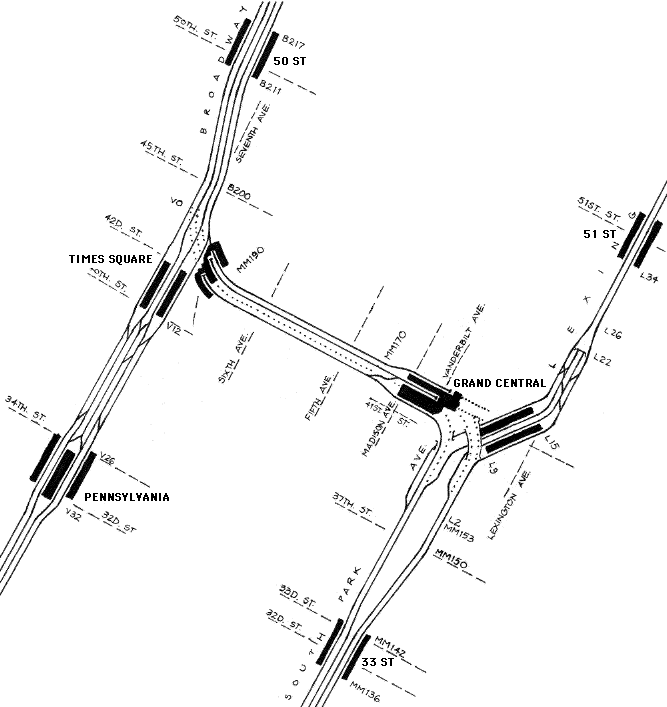
|
The diagram shows the 42 St shuttle and its relation to the Lexington Ave and Seventh Ave subways. The dotted lines show trackways still in existence but not laid with track. From the bottom, the subway runs in a cut and cover tunnel up as far as 33 St. There the route splits into two two-track rock tunnels under Murray Hill to avoid underpinning the very old New York and Harlem Railroad tunnel under the center of Park Avenue (which is now used as an automobile underpass). The northbound tunnel was relocated almost to the east building line after a rock slide during construction in 1902 caused by bad rock on the original planned line. The Lexington Ave subway junction was built 1914-1918. The new trackways drop as they run north. Only the original downtown local track was preserved, to permit service moves from the shuttle. The uptown tracks are about ten feet below the original grade at the point where they turn off. A control tower in the old uptown express trackway is visible from the front window of 6 trains running uptown. The rock tunnel ends at the curve, and cut and cover resumes. As the alignment of the original trackways curves into the old Grand Central station, it passes through the rebuilt area for the unused shuttle terminal. From the public passageway, none of the original support columns and roof are visible, since they were removed in exactly this area to open the way for the unused shuttle station. Staff passageways to the tower pass through the old curved tunnel. In Grand Central shuttle station itself, the wider south side platform resulted from covering over the site of the original downtown express track. A crossover track just outside the station connects the center track, the former uptown express track, to the former downtown local. The downtown express track between stations was removed in 1975. Note that the third operated shuttle track, the former uptown local, does not connect to the other two tracks at all. The platforms at Times Square are a makeshift arrangement of the original local platforms and a shuttle platform built in the bed of the downtown express track, all curved to follow the old track alignment. The station should have been rebuilt as part of the plan to bring the Steinway Tunnel line up to the same level, but after that plan was dropped, not much was ever done to make it better, and it suffers from the curved platforms and awkward access to the other trains at Times Square. The isolated former uptown local track connects to the Seventh Ave subway under a removable bridge. There is no wall at the end of the staion, so the continuation of the tunnel into what is now the Seventh Ave subway is plain to see. |
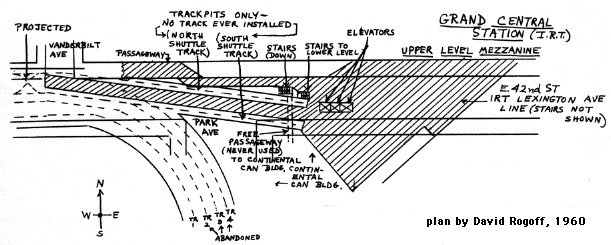
|
The sketch above is from "The Steinway Tunnels" by David Rogoff in Electric Railroads number 29, April 1960, published by the Electric Railroaders Association. It shows the unused shuttle station and its relation to some of the other passageways. The passageway north of the unused shuttle station was opened in 1916 to connect the old Grand Central station to the Steinway tunnels station, which opened in 1915. It ended at the elevators shown, which were replaced by the present set of moving stairs not long after Rogoff made this plan. As of 1918 it continued into the mezzanine level of the Lexington Ave station as shown. |
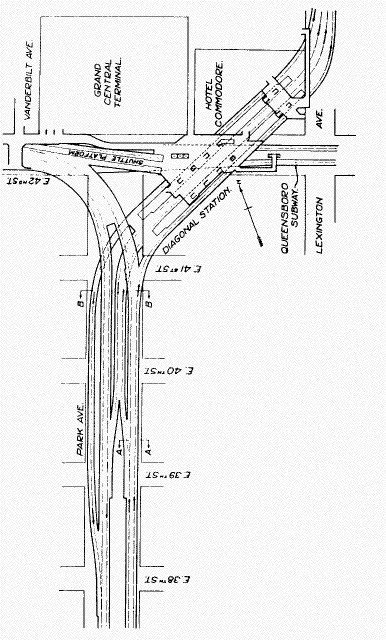
A plan from "Design of the Diagonal Station and Connection" by Olof Nilsson, in the Public Service Record volume V number 12, December 1918, shows the unused shuttle station as SHUTTLE PLATFORM. It cuts into the disused curve from Park Ave into 42 St. The Diagonal Station is the Lexington Ave subway's Grand Central station. |
|
|
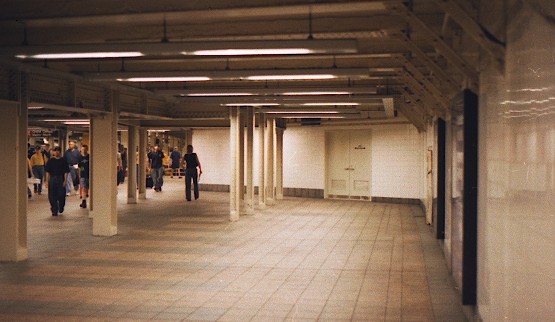
|
We are in the northern trackway of the unused shuttle station, looking west toward the open shuttle station, which can be seen in the left background. In the left foreground is the last column in the row of heavy columns down the middle of the unfinished station. Beyond, the northern trackway would have run straight into the old uptown local track, which would be in view if we could remove the walled enclosure with the double doors. To the left of that, the space between the thinner rows of columns lines up with the old uptown station platform, and the other shuttle track would have run parallel to the left of that into the former uptown express track. |
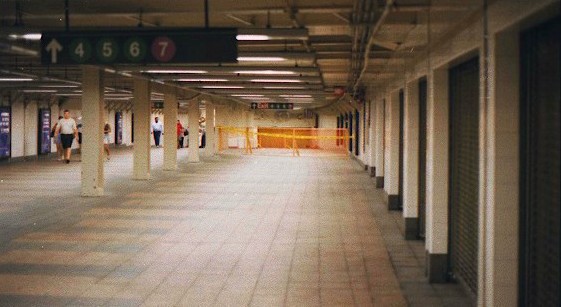
|
Turning around, we are now looking east toward the Lexington Ave subway. The line of heavy columns marks the center of the station and therefore the center of the island platform. The old subway had curved to the right here, and although the old columns were removed in 1918, there is still some trace in the ceiling of the curve. Looking where the wall meets the ceiling at right, the place where the brackets begin in the middle distance is where the unused station moves completely out of the line of the old tunnel. Closer than that, the open space of the old tunnel still exists behind the wall.
|

|
|
|
|
The film short Interior New York subway, 14th St. to 42nd St. can be downloaded from http://hdl.loc.gov/loc.mbrsmi/lcmp002.20761 from American Memory, at the Library of Congress. It shows a train running on the uptown local track. Part 2 includes the curve into Grand Central as originally built, and ends with the train leaving the station. |